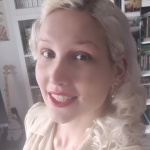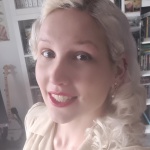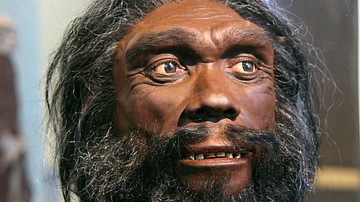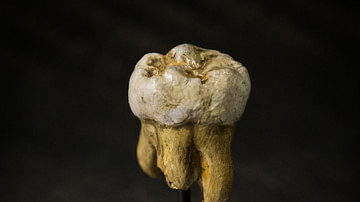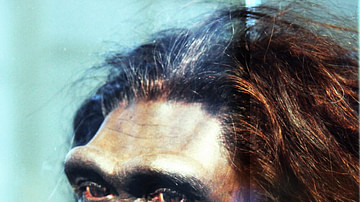
Homo floresiensis, nicknamed 'hobbit' because it only stood about 1 meter tall, is an extinct species of fossil human that lived on the island of Flores, Indonesia during the Pleistocene. Floresiensis is still shrouded in a fair bit of mystery. First excavated at Liang Bua Cave in 2003 CE, these humans were originally thought to have lived between c. 74,000- c. 12,000 years ago, which would have made them the last surviving humans besides our own species of Homo sapiens. Recent evidence suggests, however, that these humans were actually quite a bit more ancient: their bones now come in at between around 100,000 and 60,000 years ago, and the tools found alongside them range between c. 190,000-c. 50,000 years old. There are a lot of things we do not know about Homo floresiensis as of yet, including the species' exact ancestry, which is still riddled with holes.
Looks & lifestyle
These tiny people are by now known from over 100 bits and pieces that belonged to something between 9 and 14 individuals, all found at Liang Bua Cave. The type specimen (LB1) is a partially complete skeleton that is suggested to have been around 106 cm tall, while the rest of the individuals may have been a bit smaller still. Compared with other humans who lived around the same time, such as the Neanderthals (who come in at a rough average of 165 cm) and our own tall Homo sapiens, Floresiensis thus had a very different vantage point indeed.
Matching their small bodies, the only skull that has been found - belonging to the LB1 specimen - shows a brain size of around 426 cm3 (compared with roughly 1300 cm3 for Homo sapiens today). The skeletons of Homo floresiensis show a weird mosaic of features, some of which are more modern and others which are quite primitive; for instance, it had short legs in proportion to its arms, large feet (funnily matching its hobbit nickname), primitive wrist bones, but more relatively modern thumbs.
Homo floresiensis survived by hunting and gathering on an island that showed clear signs of being quite isolated and happy doing its own evolutionary thing. Some small mammals had grown larger than their mainland siblings, whereas some of the larger ones show dwarfing, like the dwarfed Flores-version of the Stegodon - an elephant-like creature which seems to have been hunted by Floresiensis. Also present were komodo dragons, giant rats, and creepy, carnivorous birds like the massive 1.8-metre tall marabou stork. Although Homo floresiensis had fairly advanced stone tools and is thought to have known fire - which would have helped them deal with all of this stuff - the more symbolic or modern vibes that come through evidence of burials or personal ornamentation are completely absent.
Unearthing their origins
Over the past decade, a whole cascade of theories has been proposed to explain who Homo floresiensis' ancestors were. Initially, there were three main ones that popped up most frequently. The first was that Homo floresiensis evolved from Asian Homo erectus and then became dwarfed after arriving on the island (dwarfism occurring on isolated islands is not unheard of); the second was that they stemmed from an early species of Homo with roots in Africa, such as Homo habilis; and thirdly, it was thought they may have been early Homo sapiens struck by some sort of disease or disorder. Frustratingly, these theories either could not properly explain all the hobbit's characteristics, or suffered from a lack of data available to push the balance in either one of these theories' favour.
Recent studies (see, for instance, Argue 2017) are shining some light into this murky muddle, though. New data suggests that Floresiensis seems to indeed be linked to an early Homo lineage rooted in Africa (more than 1,75 million years ago) and is either a sister species to Homo habilis specifically or sister to a group that spans at least Homo habilis, African and Asian Homo erectus, and Homo sapiens (and is at a similar evolutionary grade to Homo habilis). Floresiensis' ancestors must have left Africa in an, as of yet unknown, migration event, which may even have predated or almost coincided with the first steps of Homo erectus out of Africa, who are generally seen as the first Homo to have taken the plunge.
In this new scheme, Homo floresiensis is shown to not be closely related to Homo erectus or Homo sapiens specifically, and because of this distance to Homo sapiens the whole cry proposing that Floresiensis was a diseased form of Sapiens – which was already having significant trouble explaining the whole story – now seems to have landed out of the frying pan and into the fire.

Despite this clarification, there is still a huge gap between these early Homo (habilis?) living in Africa over 1,75 million years ago, and Floresiensis skeletons being present on Flores in Indonesia between c. 100,000-c. 60,000 years ago (alongside tools ranging between around 190,000-c. 50,000 years old). The only possible stepping stone so far was unearthed in 2016 CE, at the site of Mata Menge, situated on Flores at a distance of 74 km from Liang Bua Cave where the Floresiensis specimens were discovered. A piece of jaw and some teeth found there have turned out to both be a whole lot older than the Floresiensis specimens, coming in at around 700,000 years old, as well as astonishingly being about 20% smaller than the hobbits. These fragments are thus decent candidates for being the ancestors of Homo floresiensis, and if this is true, their lineage must have travelled from Africa at least once sometime between their early appearance there to landing on Flores by at least c. 700,000 years ago.
Question marks
Besides the obvious gaps in their lineage, there are more loose ends to the hobbit's story. When their ancestors went on an adventure out of Africa at an unknown point in time, there was not only a long journey standing between them and the island of Flores; the island was inconveniently surrounded by enough water so that a simple swim would not have sufficed. It has been proposed that a tsunami or other sudden displacement of water may have swept the Floresiensis lineage from nearby places such as Sulawesi onto the green shores of Flores, and for now, this idea seems to hold a tentative consensus in explaining this bit of mystery. Furthermore, were these people who arrived on the island already quite tiny, or did they grow small in its isolation (which seems plausible, but how do the c. 20% smaller Mata Menge fossils fit into this equation?)?
On the island itself there are obviously huge gaps in the hobbits' timeline, too, and we really only know the big picture – it is hard to fill in many details regarding this species' lifestyle. We also do not know exactly when they disappeared, as the lack of evidence dated beyond c. 50,000 only demonstrates that as of yet we cannot trace their existence past that point, but not that they definitely did not live for a while longer still. Furthermore, even with a date of c. 50,000 in the back of our heads, that sets Floresiensis up for having a potentially overlapping time frame with both Homo sapiens and the Denisovans in south-east Asia. Recent discoveries have shown that early modern humans made it to the more westerly Indonesian island of Sumatra between c. 73,000 and c. 63,000 years ago, and a human presence has now also been uncovered in the north of Australia dating back to around 65,000 years ago, so it is not such a strange scenario to picture these early bands of humans traversing Indonesia and bumping into the hobbits. Without any direct evidence for this, though, it remains an open question whether or not they actually met.
It might take a good while to solve this Homo floresiensis-shaped puzzle to a higher degree. But when (or if) we do, their story has the potential to add a very interesting, perhaps even overturning, aspect to the clearly complex evolutionary path of Homo. After all, the work by Tolkien that matches these people's nickname has a sequel, too.
